Dinner should be ready in about 10 minutes. Let's go into
the backyard and pick a salad. Yes, in ten minutes, and yes,
this early in the year! I t may look like everything's just
beginning, but you can actually pick a most delicious salad
for several people depending on your weed population and your
garden flowers.
For many of these plants, the tiny leaves early in the season
are the tastiest ones. Take several baskets or bags and some
scissors, we'll keep the piles all separate until we take
them inside. That way it's easier to see if we've harvested
anything by mistake.
We'll pick some wild greens and some early garden plant leaves.
You can easily supplement your own lettuce with wild greens
or go completely wild.
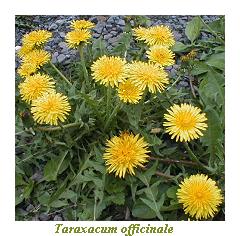 As
soon as we step outside we of course see the most famous of
weeds, Dandelion (Taraxacum officinale). Although
you can eat them all season, dandelion leaves are at their
most delicious before the plant flowers for the first time.
They make a tasty salad green.
As
soon as we step outside we of course see the most famous of
weeds, Dandelion (Taraxacum officinale). Although
you can eat them all season, dandelion leaves are at their
most delicious before the plant flowers for the first time.
They make a tasty salad green.
Snip a few leaves here and there or hold all the leaves of
a plant upright and cut the whole bunch. Cut a lot of dandelion,
making sure it is indeed dandelion by checking the back midrib
of the leaf. It should be hairless; if it's not, you may have
cut some chicory leaves.
Chicory is actually a wonderful cooked green and can be used
for salad if the leaves aren't too bitter. And if some dandelion
are already flowering, pick some of the flowers. They are
actually many flowers in each seeming blossom; you can pull
them apart and sprinkle 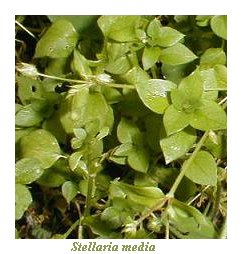 your
salad with flecks of yellow gold.
your
salad with flecks of yellow gold.
Next is Chickweed (Stellaria media), a common garden
weed that offers generous abundance in the salad department.
Identify by its bright green mouse-ear shaped leaf and tiny
white asterisk-like flowers. Chickweed grows out across the
garden spidering out, shedding its many many seeds.
Its name chickweed comes from the traditional use of collecting
the plant and letting the (many and copious) seeds fall to
the bottom, then saving them to feed chickens during the winter.
The taste of the fresh leaves flowers and stems is delightful
any time of year but especially welcome in the spring.
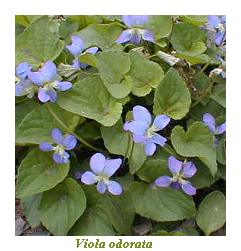
Violet (Viola odorata) will certainly attract our
attention this time of year with her exquisite flowers of
several shades of purple and white. The flowers are sweet
like candy. My almost 7 year old friend next door says they
are one of his favorite breakfast foods.
Believe it or not, these beautiful spring flowers are not
true flowers in that they do not set seed. Violet's true flowers
are green, bloom in late summer under the leaves and are pretty
invisible. The leaf of this plant is also quite delicious
most of the year through. In the spring it's mild tasting
and filled with Vitamin C when fresh.
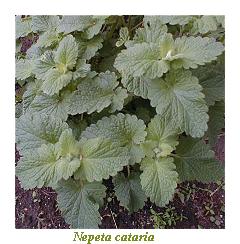 Early in the spring Catnip (Nepeta cataria) plants
are sending up small green leaves. My big catnip plant has
become a yoga mat for my cat. Especially in the sunshine when
the plant oils evaporate slightly and exude that irresistible
catnip aroma, she lies all over the plant, rubbing her face
in it and purring. Luckily I have other catnip plants that
I can graze on. The leaves this early in the spring are quite
delicious in salad, or in pesto.
Early in the spring Catnip (Nepeta cataria) plants
are sending up small green leaves. My big catnip plant has
become a yoga mat for my cat. Especially in the sunshine when
the plant oils evaporate slightly and exude that irresistible
catnip aroma, she lies all over the plant, rubbing her face
in it and purring. Luckily I have other catnip plants that
I can graze on. The leaves this early in the spring are quite
delicious in salad, or in pesto.
Just watch out for the salad that contains freshly snipped
catnip leaves; it could become an object of interest for any
felines around. And while we're at it, let's not overlook
the marvelous mint family.
Peppermint (Mentha piperita) and spearmint (Mentha
cardiaca) are among those that can be used in a wild
salad. The leaves add a lively taste, particularly chopped
very small. And speaking of the mint family, some freshly
minced leaves of oregano, thyme, basil, rosemary or lavender
can add wonderful excitement to a salad if they are up in
your garden.
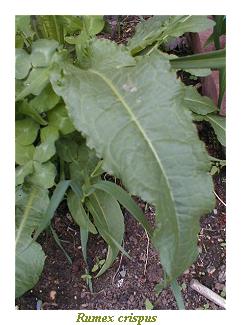 Yellow
dock leaves (Rumex crispus only , not rumex obtussifolia)
is a wonderful spring green, raw or cooked. Choose the longish
wavy leaf of crispus, not the broader one of obtussivolia.
It's quite delicioius, with a slightly sour taste, is in the
same family as sorrel. Yellow dock is used widely as a spring
tonic along with dandelion, because they both encourage healthy
flows in the liver and gall bladder.
Yellow
dock leaves (Rumex crispus only , not rumex obtussifolia)
is a wonderful spring green, raw or cooked. Choose the longish
wavy leaf of crispus, not the broader one of obtussivolia.
It's quite delicioius, with a slightly sour taste, is in the
same family as sorrel. Yellow dock is used widely as a spring
tonic along with dandelion, because they both encourage healthy
flows in the liver and gall bladder.
Plantain (Plantago major) is tender early in the
spring if it is up in your yard. Leaves are mild tasting,
contain Vitamin C and add good bulk to the salad. Not much
taste. not unpleasant.
Garlic mustard (Alliaria officinalis), a member
of the mustard family, is incredibly successful at reseeding
itself. So eat this one quite freely, please! The sharply-toothed
leaves are round or heart shaped. They are low to the ground
with 2 or 3 leaves and usually grow in patches.
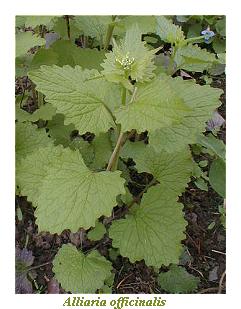 The
first wave of garlic mustard comes through in April and May.
The second wave comes through later in the summer and the
spring plants come from those seeds.Garlic mustard is a delicious
wild green. It has a light garlic flavor and is quite tasty
in salad.
The
first wave of garlic mustard comes through in April and May.
The second wave comes through later in the summer and the
spring plants come from those seeds.Garlic mustard is a delicious
wild green. It has a light garlic flavor and is quite tasty
in salad.
I must add that garlic mustard is so successful at reseeding
that in some areas it is considered a huge nuisance; it tends
to take over habitats and in many places extreme measures
are regularly taken to control its expansion. If it is about
to flower or is actually flowering, you can pinch the top
off; that will limit its expansion.
I believe a public information and training campaign might
help to control this amazinglly invasive though very useful
food weed. If everyone managed their own salad patch and if
we all helped to manage the public areas, by eating it, this
plant might learn its place in the dance of the world.
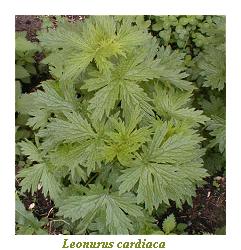 Cronewort
(Artemisia vulgaris) is a common perennial weed that
is only just beginning its leaf growth in the spring. About
2-4" in height is good for eating this plant raw in salad.
After it reaches 6-8" or so in height, it's just too
bitter. Even so, it still offers slight bitter background,
a must for every wild salad. Cut the leaves in tiny pieces
and don't use too much to start. The leaves and roots of plants
up to 10" in height can be used to make a very delicious
vinegar rich in minerals.
Cronewort
(Artemisia vulgaris) is a common perennial weed that
is only just beginning its leaf growth in the spring. About
2-4" in height is good for eating this plant raw in salad.
After it reaches 6-8" or so in height, it's just too
bitter. Even so, it still offers slight bitter background,
a must for every wild salad. Cut the leaves in tiny pieces
and don't use too much to start. The leaves and roots of plants
up to 10" in height can be used to make a very delicious
vinegar rich in minerals.
Motherwort (Leonurus cardiaca), is also quite a
bitter leaf, though not so much early in the season. Cut small
for salad. The young spring leaves of motherwort make a surprisingly
fabulous vinegar. This plant's botannical name means lion-heart,
and is in the mint family.
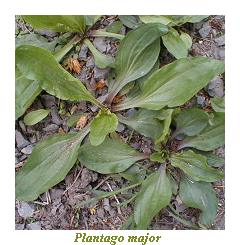 Ox-eye
daisy leaves (Leucanthemum vulgaris) are a familiar,
friendly early summer flower, the traditional daisy with white
petals and a yellow middle. Early in the season the leaves
are strinkingly sweet and provide an interesting contrast
to the other tastes of bitter and salty.
Ox-eye
daisy leaves (Leucanthemum vulgaris) are a familiar,
friendly early summer flower, the traditional daisy with white
petals and a yellow middle. Early in the season the leaves
are strinkingly sweet and provide an interesting contrast
to the other tastes of bitter and salty.
Other possibilities in the spring are young growth of last
year's plants, including chives, turnip greens, kale, collards
and arugula, garlic shoots, onion shoots.
The next time you look out the window at your lawn and garden,
you can choose to see a bunch of unwanted greens, or you can
see dinner. Remember, the best revenge against weeds is to
eat them. As we say in the wild, Sauvage Appetit!!
Disclaimer: THESE ARE SAFE, WELL-KNOWN GARDEN WEEDS. ALWAYS
USE CARE WHEN PICKING PLANTS THAT ARE NEW TO YOU. ASK SOMEONE
WHO REALLY KNOWS, AND CONSULT GOOD BOOKS. PLEASE TAKE RESPONSIBILITY
FOR IDENTIFYING ANY PLANTS MENTIONED. THE AUTHOR AND PUBLISHER
CANNOT BE RESPONSIBLE FOR INDIVIDUAL ACTIONS BY READERS.
Marie Summerwood has been working with wild plants since
1983. She also taught natural foods cooking in the Syracuse
area for 10 years. She teaches and writes about using wild
plants for food and medicine.
You Can Dress Them Up!
Recipes for you:
A few words about eating wild greens. I cut them small
as their taste is usually stronger than lettuce. If lettuce
or spinach is part of the salad, make it small as well.
Roll the leaves together like a cigar and cut into strips,
like linguine. Or tear if you must.
It is quite critical to find the right dressing for the
greens I eat. I find that with wild greens, a dressing containing
more oil tastes best, and the greens seem to digest better.
Olive is my favorite and, as a mono-unsaturated oil, is
the reported best for daily consumption. Use extra virgin
olive oil, the first pressing of the olives, for the most
taste. Greek olive oil is the highest quality, and of course
the most expensive, but Italian oil is also very delicious.
Read labels carefully. The large letters will say "Packed
In Italy" buit the small print will say the oil is
actually a blend of oils from Tunisia, Morocco and Spain.
Sad to say, these are the lowest quality oils.
Lastly, I usually eat part of my salad, saving the rest
for later, after the oil and vinegar have "cooked"
the greens. I know others who have this strange practice
as well.
LIGHT LEMON GARLIC DRESSING
Combine
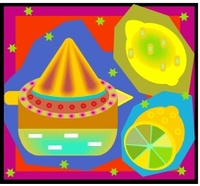 1/4 c lemon juice
1/4 c lemon juice
1/4 c good quality olive oil
2-3 TB tamari or soy sauce
2 cloves freshly & finely crushed garlic
3/4 c water.
SESAME DRESSING
Whisk together
1/3 c freshly roasted* sesame tahini
2 1/2 TB lemon juice
1 TB tamari
1/2 c water
*use a cast iron or other heavy skillet over low or medium
low heat , pour in tahini and stir very attentively until
it thickens, becomes fragrant and slightly darker in color.
Be careful not to burn yourself, it gets quite hot.
SAUERKRAUT DRESSING
2 TB olive oil (or organic bacon fat if you eat it)
1 medium onion
8 -10 oz. sauerkraut, including juice (unpasteurized if
possible)
1/2 tsp dill seed OR add 1 TB fresh chopped dillweed after
cooking
Cut onion into thin crescents. Heat oil and saute onion
until translucent. Add the rest of the ingredients including
liquid. Simmer covered if you want it hot, or blend cold
kraut with the onion, that's good too. Plus, if your kraut
is uncooked, you get more healthy additions to your gut
flora. Blend until smooth or leave chunks. Use on crackers
or bread with cheese and mustard, as a sauce on greens,
vegs, on meat dishes, etc, or as a marinade

 Marie
Summerwood, Wise Woman Center cook, has been a lover
of food and nourishment for many years. She taught macrobiotic
cooking for 10 years, then found cooking with weeds (at
Weed's) to be a natural next step. Cooking in the Wise Woman
Tradition uses any food, any technique needed for the right
nourishment of the moment. It is a sacred recognition of
the cycles of our lives, and the will to bring to it what
will best nourish. Marie recognizes that one of the deepest
spirals of life begins in the kitchen. Read about Marie's
love for her magnificent
cooking at the Wise Woman Center. Learn more about
her fabulous CD
Women's Sacred Chants.
Marie
Summerwood, Wise Woman Center cook, has been a lover
of food and nourishment for many years. She taught macrobiotic
cooking for 10 years, then found cooking with weeds (at
Weed's) to be a natural next step. Cooking in the Wise Woman
Tradition uses any food, any technique needed for the right
nourishment of the moment. It is a sacred recognition of
the cycles of our lives, and the will to bring to it what
will best nourish. Marie recognizes that one of the deepest
spirals of life begins in the kitchen. Read about Marie's
love for her magnificent
cooking at the Wise Woman Center. Learn more about
her fabulous CD
Women's Sacred Chants.
Read some other articles by Marie.
Marie teaches sometimes, at the Wise
Woman Center, in Woodstock NY.
MEMORIES FROM THE LOST PINES

Women's Sacred Chants with Marie Summerwood
 audio CD for $15
audio CD for $15
These chants were written in Bastrop Texas at a workshop called "Chantwriting for Goddesswomen". Marie Summerwood, musical artist and teacher of women's sacred music, led the day during which each of the 14 women present wrote her own chant.
see MEMORIES FROM THE LOST PINES in our Bookshop
read more about Marie Summerwood
Elements of Herbalism: Harvesting - 2 CD set |
|
Susun Weed lecture
Elements of Herbalism: Harvesting (Green Nations '08) Ethical wildcrafting and harvesting instructions for all plant parts, including leaves, roots, flowers, seeds, and bark of all annuals, bienneials, and perrenials.
2 CD set
(CD1/54 min & CD2/65 min)
PRICE: $22.50 plus shipping
Order Elements of Herbalism CD: Harvesting in our Bookshop |


 As
soon as we step outside we of course see the most famous of
weeds, Dandelion (Taraxacum officinale). Although
you can eat them all season, dandelion leaves are at their
most delicious before the plant flowers for the first time.
They make a tasty salad green.
As
soon as we step outside we of course see the most famous of
weeds, Dandelion (Taraxacum officinale). Although
you can eat them all season, dandelion leaves are at their
most delicious before the plant flowers for the first time.
They make a tasty salad green.  your
salad with flecks of yellow gold.
your
salad with flecks of yellow gold.
 Early in the spring Catnip (Nepeta cataria) plants
are sending up small green leaves. My big catnip plant has
become a yoga mat for my cat. Especially in the sunshine when
the plant oils evaporate slightly and exude that irresistible
catnip aroma, she lies all over the plant, rubbing her face
in it and purring. Luckily I have other catnip plants that
I can graze on. The leaves this early in the spring are quite
delicious in salad, or in pesto.
Early in the spring Catnip (Nepeta cataria) plants
are sending up small green leaves. My big catnip plant has
become a yoga mat for my cat. Especially in the sunshine when
the plant oils evaporate slightly and exude that irresistible
catnip aroma, she lies all over the plant, rubbing her face
in it and purring. Luckily I have other catnip plants that
I can graze on. The leaves this early in the spring are quite
delicious in salad, or in pesto.  Yellow
dock leaves (Rumex crispus only , not rumex obtussifolia)
is a wonderful spring green, raw or cooked. Choose the longish
wavy leaf of crispus, not the broader one of obtussivolia.
It's quite delicioius, with a slightly sour taste, is in the
same family as sorrel. Yellow dock is used widely as a spring
tonic along with dandelion, because they both encourage healthy
flows in the liver and gall bladder.
Yellow
dock leaves (Rumex crispus only , not rumex obtussifolia)
is a wonderful spring green, raw or cooked. Choose the longish
wavy leaf of crispus, not the broader one of obtussivolia.
It's quite delicioius, with a slightly sour taste, is in the
same family as sorrel. Yellow dock is used widely as a spring
tonic along with dandelion, because they both encourage healthy
flows in the liver and gall bladder. The
first wave of garlic mustard comes through in April and May.
The second wave comes through later in the summer and the
spring plants come from those seeds.Garlic mustard is a delicious
wild green. It has a light garlic flavor and is quite tasty
in salad.
The
first wave of garlic mustard comes through in April and May.
The second wave comes through later in the summer and the
spring plants come from those seeds.Garlic mustard is a delicious
wild green. It has a light garlic flavor and is quite tasty
in salad. Cronewort
(Artemisia vulgaris) is a common perennial weed that
is only just beginning its leaf growth in the spring. About
2-4" in height is good for eating this plant raw in salad.
After it reaches 6-8" or so in height, it's just too
bitter. Even so, it still offers slight bitter background,
a must for every wild salad. Cut the leaves in tiny pieces
and don't use too much to start. The leaves and roots of plants
up to 10" in height can be used to make a very delicious
vinegar rich in minerals.
Cronewort
(Artemisia vulgaris) is a common perennial weed that
is only just beginning its leaf growth in the spring. About
2-4" in height is good for eating this plant raw in salad.
After it reaches 6-8" or so in height, it's just too
bitter. Even so, it still offers slight bitter background,
a must for every wild salad. Cut the leaves in tiny pieces
and don't use too much to start. The leaves and roots of plants
up to 10" in height can be used to make a very delicious
vinegar rich in minerals. Ox-eye
daisy leaves (Leucanthemum vulgaris) are a familiar,
friendly early summer flower, the traditional daisy with white
petals and a yellow middle. Early in the season the leaves
are strinkingly sweet and provide an interesting contrast
to the other tastes of bitter and salty.
Ox-eye
daisy leaves (Leucanthemum vulgaris) are a familiar,
friendly early summer flower, the traditional daisy with white
petals and a yellow middle. Early in the season the leaves
are strinkingly sweet and provide an interesting contrast
to the other tastes of bitter and salty. 1/4 c lemon juice
1/4 c lemon juice
 Marie
Summerwood, Wise Woman Center cook, has been a lover
of food and nourishment for many years. She taught macrobiotic
cooking for 10 years, then found cooking with weeds (at
Weed's) to be a natural next step. Cooking in the Wise Woman
Tradition uses any food, any technique needed for the right
nourishment of the moment. It is a sacred recognition of
the cycles of our lives, and the will to bring to it what
will best nourish. Marie recognizes that one of the deepest
spirals of life begins in the kitchen. Read about Marie's
love for her
Marie
Summerwood, Wise Woman Center cook, has been a lover
of food and nourishment for many years. She taught macrobiotic
cooking for 10 years, then found cooking with weeds (at
Weed's) to be a natural next step. Cooking in the Wise Woman
Tradition uses any food, any technique needed for the right
nourishment of the moment. It is a sacred recognition of
the cycles of our lives, and the will to bring to it what
will best nourish. Marie recognizes that one of the deepest
spirals of life begins in the kitchen. Read about Marie's
love for her 


